#rue Bonaparte
Text
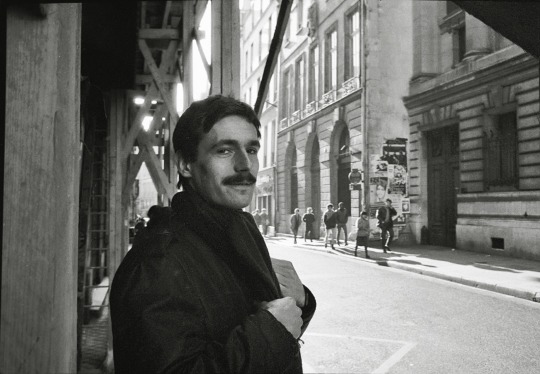
1975 Paris, rue Bonaparte, Ecole des Beaux-Arts
#1974#Paris#rue Bonaparte#Beaux-Arts#vintage#1970s#analog photography#film photography#photography#original photographers#streetphotography#blackandwhite#pierre wayser
19 notes
·
View notes
Photo

24 décembre 1800 : attentat de la rue Saint-Nicaise contre Bonaparte ➽ http://bit.ly/Attentat-Bonaparte Premier attentat à la bombe contre un chef d’État, l’explosion rue Saint-Nicaise à l’instant même où la voiture de Bonaparte se dirige vers l’Opéra en cette veille de Noël cause nombreuses victimes et considérables dégâts matériels : si le Premier consul n’est pas touché, le drame marque l’opinion publique et donne bientôt lieu à des arrestations massives dans le milieu des jacobins, avant que trois chouans, véritables auteurs de l’attentat, ne soient identifiés au terme d’une enquête tant administrative que scientifique
#CeJourLà#24Décembre#Attentat#Bombe#Bonaparte#Premier#Consul#Rue#SaintNicaise#Opéra#Veille#Noël#Police#Enquête#Chouans#Jacobins#Fouché#Drame#Victimes#histoire#france#history#passé#past#français#french#news#événement#newsfromthepast
10 notes
·
View notes
Text

The attack on Rue Saint-Nicaise in Paris on 24 December 1800
The coach of the First Consul Napoleon Bonaparte went to gallop and avoids the bomb.
by Jacques Marie Gaston Onfray de Bréville
#napoléon bonaparte#napoleon#bonaparte#napoleonic#carriage#paris#france#coach#assassination#bomb#napoléon#conspiracy#saint-nicaise#art#history#europe#plot#plot of rue saint-nicaise#first consul#machine infernale#royalists#royalist#breton chouans#attack#job#jacques marie gaston onfroy de bréville#european#jacques onfroy de bréville
40 notes
·
View notes
Photo






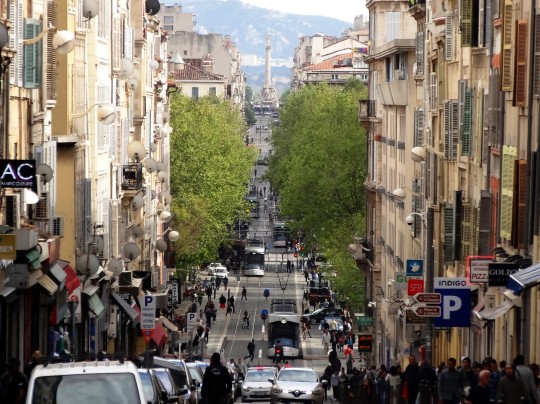
Je reviens ENCORE une fois à mon projet de présenter la plupart de mes 55800 photos (environ). On est en 2017 et comme ce blog est né en 2017, j’arriverai donc au bout de cette présentation.
Marseille, au printemps. L'Arc de Triomphe de la Porte d’Aix. aux bas-reliefs très napoléoniens (j’aime bien le petit garçon chassant un caniche hargneux à coups de sabot !) Et de là, la longue enfilade courant par le Cours Belsunce puis la Rue de Rome jusqu’à la place Castellane.
#souvenirs#marseille#arc de triomphe#porte d'aix#place jules guesde#napoléon premier#bonaparte#caniche#place castellane#cours belsunce#rue de rome
5 notes
·
View notes
Text
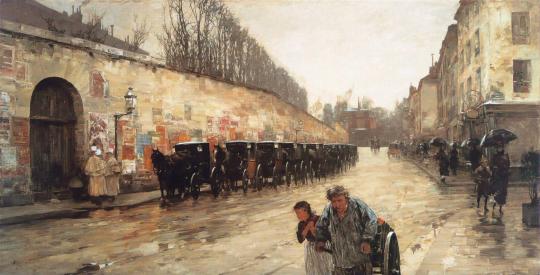
-Cab Station, Rue Bonaparte-
76 notes
·
View notes
Text
Gaudin’s description of Napoleon
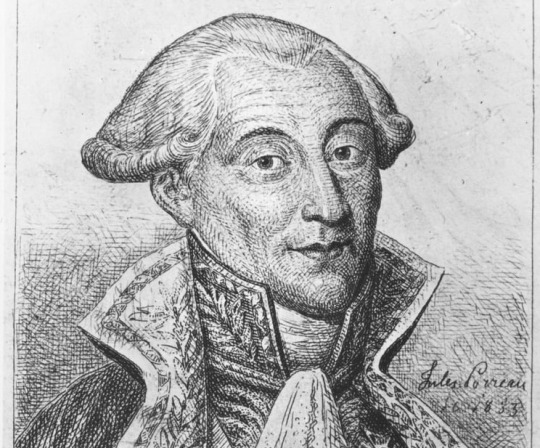
Martin-Michel Gaudin was Napoleon’s Minister of Finance. He entered the world of finance at the age of 17 and achieved the highest rank a non-aristocrat could achieve in finance administration pre-Revolution (“first clerk”). During the Revolution, he was the Commissioner of the National Treasury. He left government in 1795 and resisted further governmental recruiting attempts until Napoleon (who he had never met) approached him in 1799. Gaudin describes their first meeting in his memoir:
I found a personage who was known to me only by the high reputation he had already acquired; of low stature, dressed in a gray frock coat, extremely thin, yellow complexion, eagle-eyed, with lively movements [...] he came to me with the most gracious air.
“You have,” he said, “worked in finance for a long time?”
“Twenty years, General!”
“We need your help badly, and I’m counting on it. Come on, take your oath, we’re in a hurry.”
This formality completed, he added: “The last minister of the Directory will be informed of your appointment. Meet in two hours at the ministry to take possession of it, and provide a report on our situation as soon as you can, as well as on the first measures to be taken to restore the service which is lacking everywhere. Come see me this evening at my house on rue de la Victoire (that’s what rue Chantereine was then called), we will discuss our business more fully.”
I withdrew to carry out the orders I had just received.
(Source: Gaudin, Mémoires, souvenirs, opinions et écrits du duc de Gaète, pp. 45-46)
Historian Pierre Branda on their partnership:
“Intuition, good advice or genius? Bonaparte’s choice was judicious, because Gaudin would successfully occupy this ministerial post for the entire duration of the Consulate and the Empire, including the Hundred Days. With such longevity, he was undoubtedly one of Napoleon’s most appreciated ministers. It is true that the two men were often in perfect agreement.”
(Source: Le prix de la gloire: Napoléon et l’argent, pp. 197)
#Pierre Branda#Martin-Michel Gaudin#Gaudin#Napoleon#napoleon bonaparte#napoleonic era#napoleonic#first french empire#french empire#france#history#finance#economics#19th century#french history#minister of finance#1800s#Le prix de la gloire: Napoléon et l’argent#Le prix de la gloire#Napoléon et l’argent#description of Napoleon#description#Branda
60 notes
·
View notes
Text

Poster by Georges de Feure for 5th Exposition du 1er au 31 octobre (1894), Salon des Cent, 31 rue Bonaparte.
Published by Bourgerie & Cie.
Bibliothèque nationale de France.
46 notes
·
View notes
Text
On March 16 [1815], the very next day after the private interview between the Duke of Otranto and Louis’ brother, a detail of royalist police was dispatched to the Rue Cerutti to arrest Fouché. The reasons for this action are unclear. (…) On the policemen’s arrival at his Rue Cerutti residence, Fouché delayed agent Foudras of the Paris prefect in the entryway with some complaints about the formalities of the arrest warrant. (Fouché would later put Foudras on his payroll.) Suddenly, Fouché bolted through a secret door and down the hallway, ran out into his garden, and scrambled up a ladder which he had left leaning against the wall. He thereupon dropped down into the adjacent garden, behind the mansion belonging to Napoleon’s stepdaughter and Louis Bonaparte’s estranged wife, Queen Hortense… and fled out into the street. From there the Duke of Otranto, apparently quite spry for someone almost 56, threw off his pursuers by hopping into a carriage, and made his way to the safe-house of a retired secretary-general of the Paris police (a former Oratorian), to await the imminent collapse of the Bourbons.
—Rand Mirante, Medusa’s Head: The Rise and Survival of Joseph Fouché, Inventor of the Modern Police State
Foudras: we have a warrant for your arrest
Fouché:

49 notes
·
View notes
Text
Victor Hugo on Talleyrand's death
For @empirearchives who was interested, here's a translation of Victor Hugo's text about Talleyrand's death. My thanks to @microcosme11 for her help <33
Choses Vues, Victor Hugo
1838
Talleyrand
19th of May
In the Rue St-Florentin, there is a palace and a sewer.
The palace, with its noble, rich, and dull architecture, was long called "Hôtel de l'Infuntado"; today, we read on its front door: Hôtel Talleyrand. During the fourty years he lived on this street, the last host of this palace might never have set eyes on this sewer.
He was a stranged, feared, and considerable character: his name was Charles-Maurice de Périgord; he was noble as Machiavel, a priest like Gondi, defrocked like Fouché, witty as Voltaire, and lame as the devil. One could say that everything limped with him: the nobility which he had put to the service of the republic, the priesthood he had dragged on the Champ-de-Mars then threw down the drain, the marriage he had broken by twenty scandals and by a voluntary separation, the wit he dishonoured through vileness. This man, nevertheless, had grandeur.
The splendours of both regimes were mixed together inside of him: he was prince of the old kingdom of France, and prince of the French Empire.
For thirty years, from the depth of his palace, from the depth of his mind, he had just about led Europe. He had let the revolution call him "tu", and had smiled at it, ironically of course; but it had not noticed. He had approached, known, observed, pierced, stirred, upturned, delved into, mocked, intellectually fertilized all the men of his era, all the ideas of his century, and there had been a few minutes in his life when, holding in his hand the four or five fearsome threads that moved the civilized universe, he had had for a puppet Napoleon the First, Emperor of the French, King of Italy, Protector of the Confederation of the Rhine, Mediator of the Swiss Confederation. Such was the game this man played.
After the Revolution of July, that old race, whose grand chambellan he was, having fallen, he found himself standing on one foot and told the people of 1830, sitting, bare-armed, on a pile of cobbles: Make me your ambassador.
He had received Mirabeau's last confession and Thiers' first confidence. He had said himself he was a great poet and had made a trilogy in three dynasties: Act I, Buonaparte's Empire; Act 2, The House of Bourbon; Act 3, The House of Orleans.
He had done all of this in his palace, and, in this palace, like a spider in its web, he had attracted into it and taken successively heroes, thinkers, great men, conquerors, kings, princes, emperors, Bonaparte, Sieyès, Mme de Staël, Chateaubriand, Benjamin Constant, Alexander of Russia, Wilhelm of Prussia, Francis of Austria, Louis XVIII, Louis-Philippe, all the golden, shiny flies who buzzed in the history of those last fourty years. The whole sparkling swarm, fascinated by this man's deep eye, had successively passed under the dark door that bore, written on its architrave: Hôtel Talleyrand.
Well, the day before yesterday, 17 March, 1838, that man died. Doctors came and embalmed the corpse. For this, like the Egyptians, they first withdrew the bowels from the belly and the brain from the skull. Once done, after they had transformed the prince de Talleyrand into a mummy, and nailed this mummy in a white satin-lined coffin, they withdrew, leaving upon a table the brain, that brain which thought so many things, inspired so many men, built so many edifices, led two revolutions, fooled twenty kings, contained the world.
Once the doctors were gone, a valet entered, he saw what they had left. Hold on! they forgot this. What to do ? He remembered that there was a sewer in the street, he went there, and threw that brain into this sewer.
Finis rerum.
73 notes
·
View notes
Text

Andras Lapis. Bajo el sombrero. (sous le chapeau) Yeso original creado en 1975. Sin embargo, la primera estatua fundida de esta no se realiza hasta 1992. Se encuentra en Szeged, una ciudad del sur de hungría. Su gemelo parisino, ofrecido al Instituto Húngaro por el artista, expuesto por primera vez en el interior, encuentra su lugar en la rue Bonaparte desde 2007.
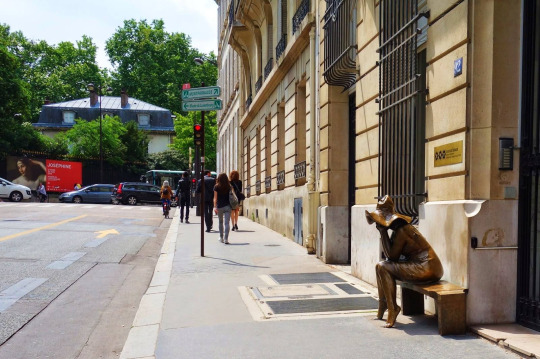



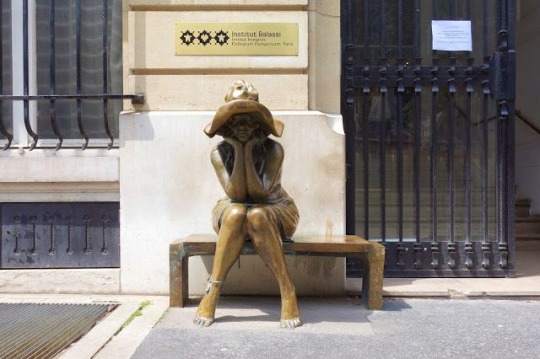




8 notes
·
View notes
Text

1975 Paris, rue Bonaparte, Ecole des Beaux-Arts
#1975#paris#ecoledesbeauxarts#atelier#trix#vintage#analog#filmphotography#1970s#photography#photooftheday#photographylovers#photo#pentax#spotmaticf#streetphotography#photozine#original photographers#pierre wayser
57 notes
·
View notes
Photo
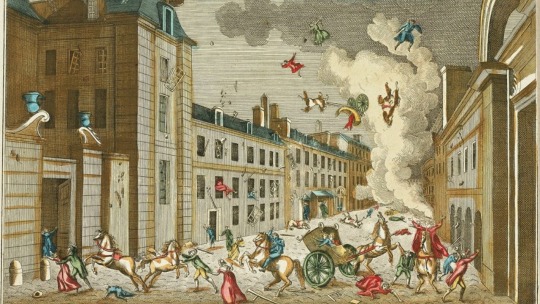
24 décembre 1800 : attentat de la rue Saint-Nicaise contre Bonaparte ➽ https://bit.ly/3xaie6Y Premier attentat à la bombe contre un chef d’État, l’explosion rue Saint-Nicaise à l’instant même où la voiture de Bonaparte se dirige vers l’Opéra en cette veille de Noël cause nombreuses victimes et considérables dégâts matériels : si le Premier consul n’est pas touché, le drame marque l’opinion publique et donne bientôt lieu à des arrestations massives dans le milieu des jacobins, avant que trois chouans, véritables auteurs de l’attentat, ne soient identifiés au terme d’une enquête tant administrative que scientifique
#CeJourLà#24Décembre#Attentat#Bombe#Bonaparte#Premier#Consul#Rue#SaintNicaise#Opéra#Veille#Noël#Police#Enquête#Chouans#Jacobins#Fouché#Drame#Victimes#histoire#france#history#passé#past#français#french#news#événement#newsfromthepast
6 notes
·
View notes
Text
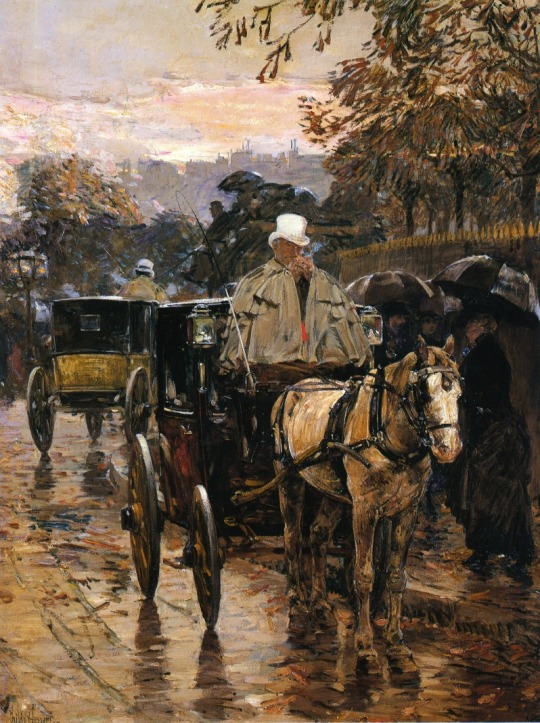
Title: Hackney Carriage, Rue Bonaparte
Artist: Childe Hassam
Date: 1888
Style: Impressionism
Genre: Genre Painting
#art#art history#painting#impressionism#genre painting#history of art#artist#arthistory#artgallery#artwork#paintings
177 notes
·
View notes
Text
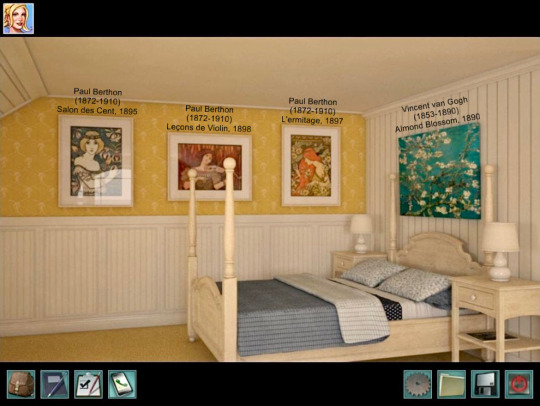
Happy Saturday, Clue Crew! I want to talk about the art displayed, next to Nancy Drew’s bed (as seen in Alibi in Ashes). I’ve already discussed (in a previous post) how Alphonse Mucha is featured, quite prominently, in several of the ND games. At a glance, one might think the three, framed posters, on the yellow wall, are his work. However, they were done by a contemporary of Mucha, named Paul Berthon. Like Mucha, Berthon worked in the Art Nouveau style, which is why it is easy confuse their pieces!
Paul Berthon…was a French artist who produced primarily posters and lithographs… Berthon studied as a painter in Villefranche-sur-Saône before moving to Paris… His study of the decorative arts influenced his print making, influencing the strong lines and natural details that guided his art. The vast majority of Berthon's lithographed posters did not include advertisements and were meant to stand on their own.
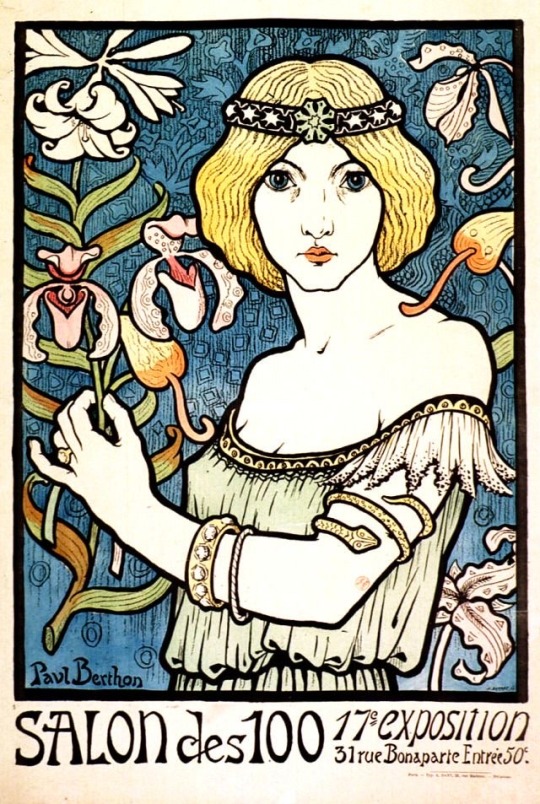
The piece on the far left, of Nancy’s wall, is a print named The Salon de Cent (Salon of the One Hundred). If you are unfamiliar what “the Salon” is, in reference to art history, it was:
…the official art exhibition of the French Academy of Fine Arts (Academie des Beaux-Arts) in Paris. First held in 1667, its name stems from its location at the Salon Carre in the Louvre. For almost 150 years…the Salon was the most prestigious annual or biannual art event in the world.
The aforementioned print, was advertising Salon des Cent, which was a commercial art exhibition in Paris, based at 31 Rue Bonaparte.
The Salon sold color posters, prints and reproductions of artwork to the general public at reasonable prices. The Salon held exhibitions until 1900. Many of the posters advertising Salon des Cent exhibitions have themselves become collectors’ items.
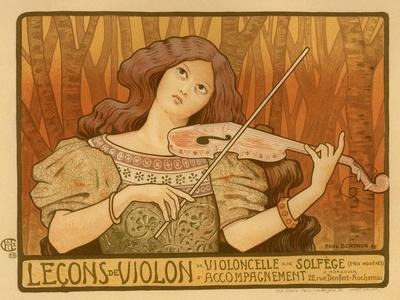
The middle poster of Nancy’s Art Nouveau collection, is another advertisement, for violin lessons (Leçons de Violin).
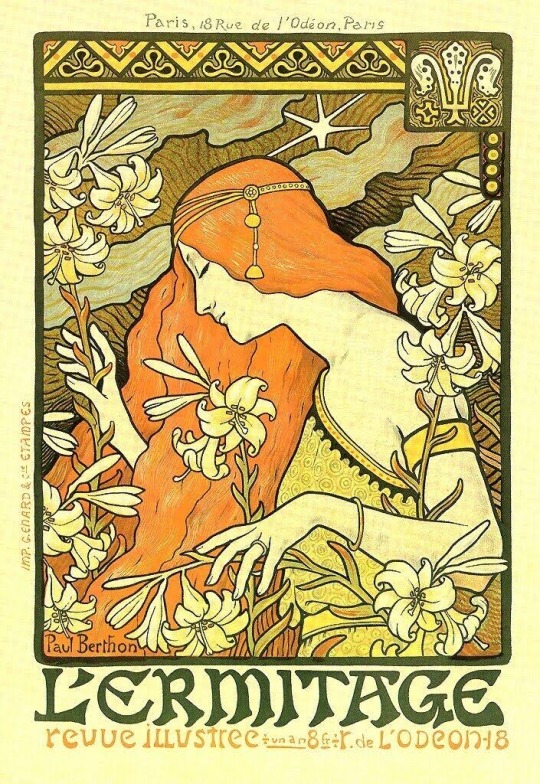
The last poster of the trio is L’Ermitage.
L’Ermitage was a monthly, literary review that was published in Paris, France between 1890 and 1907.
The publication came under new management in 1896 during which time the literary review was reorganized. Subjects included in the magazine expanded beyond poetry and plays to also include that of the visual arts. With the expansion of subjects, the editors decided to commission Art Nouveau illustrations to grace the covers…
Art Nouveau reflects the ideals and desires of Paris at the end of the nineteenth century, which include happiness and indulgence in life and beauty without all the turmoil and problems of the newly industrialized world. In this piece, Berthon uses a woman with long, flowing hair and flowers as a symbol of beauty and purity. The print consists of just four colors in addition to the black ink.
L’Ermitage was included in the Les Maitre de L’Affiches series, or Masters of the Poster. This series was originally offered as a subscription for collectors, in which a different poster was mailed out monthly and which could be bound together at the end of the year. L’Ermitage was mailed out in 1900 as plate 227 of the series. These posters were greatly appealing due to their smaller, more manageable size, and the high quality of printing materials. The original larger posters usually had to be rolled up to store and were printed with a lesser quality ink.
A lithograph copy of L’Ermitage is currently on display at the Los Angeles County Museum of Art in Los Angeles, California, the United States.
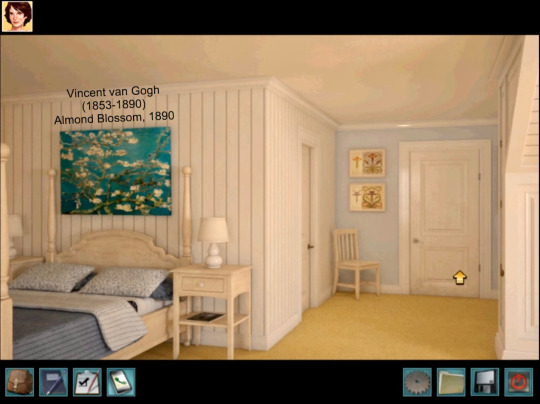
That does it, for the posters, on the yellow wall! But you’ll notice a canvas, prettily centered over Nancy’s bed. This is the very recognizable Almond Blossom, by the one and only, Vincent van Gogh.

You’ll see that the piece, in ASH, is a mirrored image, of van Gogh’s original. I can only assume this was done for copyright purposes, but that’s just conjecture.
Vincent loved nature. Blossoming trees, like in the painting Almond Blossom, were one of his favourite subjects to paint. He painted a number of variations on the theme: ranging from a small flowering sprig in a glass to lavishly blossoming trees.
Almond trees flower early in spring. The tree therefore marks the arrival of spring and the start of new life. And that was very appropriate in this case, as Vincent didn’t paint this work for just any old reason…
The painting was a gift for Vincent’s newborn nephew. The boy was born on 31 January 1890, and Theo and his wife Jo named him Vincent, after his uncle. Van Gogh was delighted to hear the news: ‘It does me, too, more good and gives me more pleasure than I could express in words’.
The painting became a treasured possession as soon as Vincent presented it to Theo and Jo as a gift. At first, it hung prominently above the piano in Theo and Jo’s living room. Later, once Jo had moved to Bussum following Theo’s death, the work hung in her and her son Vincent’s bedroom.
Following the death of Vincent and Theo, all of Vincent’s paintings passed into Jo’s hands. She sold a number of works during her lifetime, but Almond Blossom was so precious to Jo and her son that it was never to be sold. And that’s why to this very day, it is on display at the Van Gogh Museum.
For Van Gogh, painting Almond Blossom signified a new start. At the time, he had already been at an asylum in Saint-Rémy for almost ten months. Due to an attack of his illness, Vincent had not worked for weeks. He was now allowed back outside to paint, surrounded by nature.
Vincent worked hard, but that cost him dearly. Once he had completed the painting at the end of February, he had an attack that lasted for two months; his longest ever crisis. Once he had recovered, a new disappointment awaited: Vincent had missed his beloved flowering season.
‘If I’d been able to continue working, […] I would have done others of the trees in blossom. Now the trees in blossom are almost finished, […] I have no luck’.
Vincent chose an unusual perspective for Almond Blossom. He painted the branches from below and very close up. It is as if you are lying on your back on the grass, looking up at the branches above you, so that you can no longer see the entire tree. Vincent had seen this approach in Japanese printmaking and was inspired by it. These prints often zoom in on details from nature, and the image was sometimes cropped.
The subject itself also feels very Japanese, as blossom played a significant role in Japanese printmaking.
There you have it! I hope this information helps you appreciate ASH and Nancy’s room, a little more. I know I really appreciate the art, featured in the Nancy Drew games. I think it’s part of why I went into art history, to begin with! I owe a lot, to these games.
That is all. Happy scrolling.
#nancy drew#her interactive#clue crew#alibi in ashes#ash#vincent van gogh#paul berthon#nancy drew pc games#art nouveau
55 notes
·
View notes
Text

Description of Caroline Bonaparte Murat:
“Still, she saw Mme. Bacciocchi frequently, and especially her sister Caroline. Caroline Bonaparte (Mme. Murat) more nearly resembled Napoleon than any of his other sisters. She had a dazzling complexion; and, though not as regularly beautiful as Pauline, she was of the true Napoleon type. Her intellect was bright, and her will imperious. The contrast between the almost infantile expression of her countenance and the decision of her character rendered her peculiarly charming. She was just married, and continued to attend all the parties in the Rue du Mont Blanc.”
Source: Memoirs and Correspondence of Madame Récamier (1867)

#painting by:#Jean Louis Hector Viger-Duvigneau#Caroline#caroline bonaparte#Murat#caroline Murat#Napoleon’s sisters#Napoleon’s family#Madame récamier#Juliette récamier#récamier
31 notes
·
View notes
